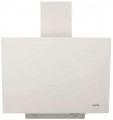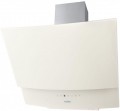Modes
Modes supported by the hood.
—
Extraction only. The device draws in the air in the room and takes it to the ventilation shaft or directly to the street. It is a very effective way to clean the air from pollution: all impurities, including odours, are simply removed. However, when the hood is operated in this mode, you must either open windows or provide adequate ventilation. Because of this, this mode is not always appropriate: for example, in the cold season, not only pollution but also heat can fly out into the chimney. Therefore, in most modern hoods, a recirculation mode is also provided.
—
Recirculation. An operating mode in which the hood does not draw air from the room but drives it through its own filters. This mode is not as effective in terms of air purification as extraction. To effectively remove odours you need to use absorbent filters, that have a limited service life. On the other hand, recirculation does not require an intensive flow of outside air, which in some situations is important — for example, in the cold season, when it is undesirable to blow out the heated air from the room.
The vast majority of modern hoods support
both modes of operation. Occasionally, some models are not compatible with carbon filters and work only in extraction mode; even rarer — devices with recirculation only mode.
Flow of air (motor)
The maximum flow of air or motor flow of air indicates the theoretical capability of the device. This parameter of the hood (motor) is measured during idle operation. By connecting the duct and working in the appropriate mode of extraction, the flow of air will be lower. However, high-performance motors will also give a high flow of air in extraction mode.
Flow of air (extraction)
The performance of the hood in extraction mode at maximum speed shows the real possibilities for air purification. Since this parameter is several times less than the motor performance (maximum performance), not all manufacturers indicate this value, trying to present large and beautiful numbers. A similar situation can be observed among other devices. For example, in vacuum cleaners, the total power is many times greater than the suction power; in acoustics, mediocre brands prefer to list peak power instead of nominal power. Therefore, motor performance and extraction performance can not be compared. However, high-performance motors will also give high performance in extraction mode. And it may well be that the conditional Bosch with an extraction performance of 300 m³/h will be better than another hood with a maximum motor performance of 500 m³/h.
Ability to install carbon filter
The ability to install an additional carbon filter in the hood — in addition to the grease filter (see above).
It provides finer air purification than a grease mesh: the carbon filter is capable of retaining impurities literally at the molecular level. Due to this, it is possible to effectively clean the air from not only kitchen fumes but also odours that are not associated with smoke, steam and other relatively large impurities. However, the carbon filter has a limited service life, and it has to be changed from time to time (cleaning, in this case, is not an option).
Note that, in this case, we are talking only about the compatibility of the hood with a carbon filter. The filter itself may not be supplied. However, in many models with this function, it is available as an option (included or not included in the kit at the request of the user).
Lighting
Lighting method provided as standard in the hood.
— Incandescent lamp. The simplest and most affordable of modern lighting sources. The main advantage of incandescent lamps is their low cost. In addition, they give a fairly eye-pleasing light in warm colours. On the other hand, such lamps are the most energy-intensive. Besides, they get very hot during operation.
— Halogen lamp. An improved version of the incandescent lamps described above. They are distinguished by higher brightness at lower power consumption while also having a spectrum of luminescence that is pleasing to the eye. At the same time, halogen lamps are still inferior in terms of efficiency to fluorescent and LED lamps.
— Fluorescent lamp. Also known as "fluorescent light bulbs" or "energy-saving light bulbs". One of the advantages of such lamps is just low power consumption — many times lower than that of incandescent lamps (although higher than that of LEDs). The light from fluorescent lamps is white, rather cold; this can be both an advantage and a disadvantage, depending on personal preferences and interior features. But of the unambiguous shortcomings, it is worth noting that most of these lamps contain mercury vapour in the flask; because of this, failed light bulbs must be disposed of according to special rules, and a broken lamp can become a source of health problems.
—
Light-emitting diodes (LED). The most advanced of mod
...ern lighting sources. LEDs are highly energy-efficient. They are more economical than incandescent lamps, and they practically do not heat up during operation. The light from such sources is neutral white, which is quite suitable for most cases. The disadvantage of LEDs is a rather high price.
Note that many modern hoods allow you to replace a regular light source — for example, a halogen lamp can be changed to a fluorescent or LED lamp with the same base.Display
The hood has its own display. Usually, this is the simplest
LCD screen for two or three characters, sometimes with additional indicators. However, even such a screen makes device control more convenient and visual: it can display the current operating mode, information about the sleep timer (see Sleep timer), the status of filters (see Filter indicator), etc.
This function rarely is used in inexpensive hoods with the simplest functionality. Therefore, the display is usually a sign of an expensive and advanced model.
Duct diameter
The duct diameter characterizes the size of the hood outlet to which the ducts are connected. The standard is either
120 mm or
150 mm. In many cases, an adapter from one diameter to another can additionally be included with the device. However, when replacing the hood with a new one, it is still better to operate with the existing pipe diameter and not use adapters.
Height (min)
The minimum height of the entire hood structure is from the lower edge to the upper part of the body (the point of connection of the external air duct). This parameter is indicated only for hoods with an adjustable design that allows you to change the height. Pay special attention to the minimum height if the device is planned to be installed in a kitchen with a low ceiling. In this case, it should be assumed that the optimal height of the air intake above the hob is 60-80 cm, and between the hood body and the ceiling, a headroom is required for the air duct. With a low ceiling, a hood that is too large may simply not fit into your kitchen.
Height (max)
The height of the entire hood structure is from the lower edge to the upper part of the body (the point of connection of the external air duct). For hoods with an adjustable design that allows you to change the height of the case, the maximum height is the size of the device in the unfolded state; in the case of non-adjustable hoods, this means a correspondingly constant overall height. When choosing a hood in height, it is worth proceeding from two points:
1. The optimal height of the air intake above the hob is 60-80 cm. This height allows the hood to capture kitchen fumes effectively and, at the same time, gives enough space to work with the hob.
2. Between the hood body and the ceiling, a clearance is required for connecting an external air duct.

